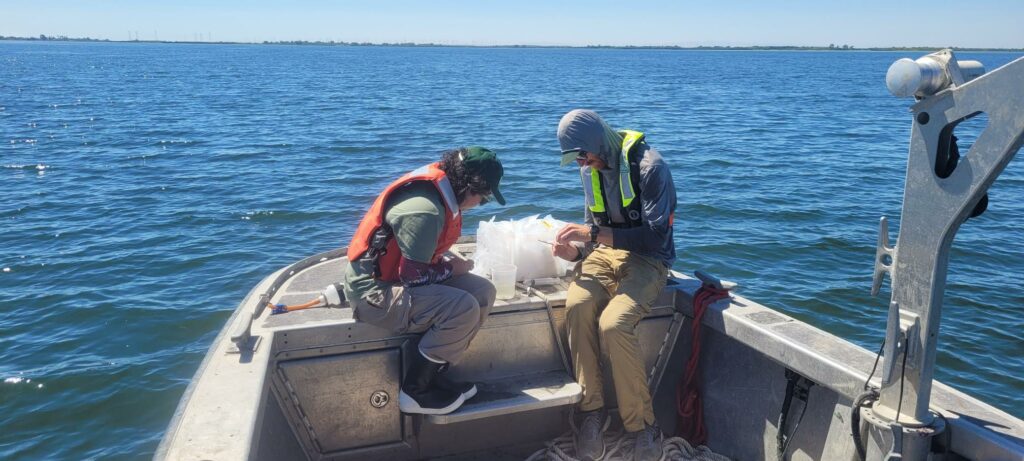Dead fish belly up in Lake Merritt and San Francisco Bay this past August sent scientists like Keith Bouma-Gregson scrambling to pinpoint the cause. A harmful bloom of marine algae had taken up residence in the Bay, and while many of the fish died from the resulting lack of oxygen in the water, toxins produced by the algae could have played some role, says Bouma-Gregson, a biologist with the US Geological Survey and regional expert on HABs. The Delta is no stranger to HABs, which in recent years, with warming temperatures and drought, have been on the rise. But an event like the one in San Francisco Bay—a different kind of algae with different impacts but a harmful bloom nonetheless—hadn’t occurred in a decade.
Galvanized by visible loss of life, from bat rays to leopard sharks, citizens started taking pictures and making counts, while local science groups and government agencies scrambled to create a digital place to collect their observations. “When an event like this is so large, it can be hard to cover every location being impacted,” says Bouma-Gregson. “But that’s one of the really amazing things about the 21st century. With GPS and cameras on our phones, you can really transfer information very quickly!”
Despite the increasing alarm over HABs, there is no coordinated or funded strategy to monitor them in the San Francisco Estuary. To explore prospects, the Delta Stewardship Council is holding a two-day workshop November 8-9. Meanwhile, Bouma-Gregson covers a few basics on harmful algal blooms in this brief Q & A and [link the following to the Science in Short Podcast] longer online audio interview.
Q: What are HABs?
A: Harmful algal blooms occur when algae grow rapidly and accumulate in the water column. When the abundance of algal cells is high it can negatively impact ecosystem health and human health.
Q: Why are they a problem for Delta fish, dogs, and people?
A: HABs are a problem for people and pets primarily because many HAB species can produce toxins which are harmful to humans, mammals, and other animals. In the Delta, HABs are formed by a group of photosynthetic bacteria called Cyanobacteria. Not all cyanobacteria produce toxins, but if a bloom is producing toxins and the concentrations become elevated then that could result in negative symptoms or an illness. The primary exposure route is ingestion, which involves accidentally, or in the case of animals or small children, intentionally drinking water with cyanobacterial cells.
Q: Can HABs get into our drinking water?
A: Cyanotoxins can be treated by drinking water plants but require additional treatment considerations and staff time to deal with their presence. Besides toxins, cyanobacteria produce compounds which cause taste and odor and clogging issues for drinking water providers.
Q: How are the recent fish kills in San Francisco Bay different than Delta blooms?
A: The organisms that bloom in the Delta and the Bay are very different. In freshwaters, like the Delta, HABs are primarily formed by cyanobacteria, a group of photosynthetic bacteria. In coastal waters or estuaries, like the Bay, HABs are usually formed by eukaryotic algae, which are more complex than cyanobacteria.
Unlike most Delta blooms, the HAB in the Bay had a major impact on dissolved oxygen concentrations. When a bloom starts to decline, the algal cells die and sink to the bottom. Bacteria then begin decomposing the algal cells, this process uses oxygen and can deplete the oxygen in the water column. When this occurs, other animals do not have enough oxygen to survive, and suffocate in the water.

Q: How do you monitor HABs?
A: For citizens, a few tell-tale signs are water that is discolored, or has streaking at the surface. For scientists and water quality managers, we use both images from satellites orbiting the earth as well as on-the ground collection of water samples and measurements of different constituents in the water. Blooms are quite dynamic, changing over the course of days to weeks, and also being moved by currents and winds. Intensive monitoring can be challenging and costly, but some areas have been able to train community members to identify HABs in the field or under a microscope. These community scientists then alert relevant agencies when they begin to see signs of a HAB developing.
Q: Are HABs worse now because of climate change?
A: If winters become milder, then that would extend the time-period favorable for freshwater HABs to occur in the Delta. Any phenomenon that increases one of these four factors—light, temperature, nutrients, and water-column dynamics—would increase the chance of HABs formation. Our water- and land-use policy and management decisions will be important in offsetting any potential climate impacts so we can minimize HAB formation California’s rivers, lakes, Delta and other waterways.